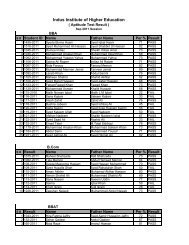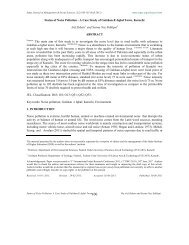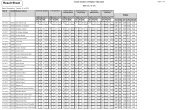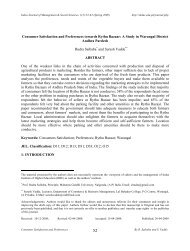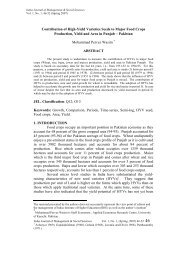2-A Daily Flow Profile of Traffic in an Urban Traffic.pdf
2-A Daily Flow Profile of Traffic in an Urban Traffic.pdf
2-A Daily Flow Profile of Traffic in an Urban Traffic.pdf
You also want an ePaper? Increase the reach of your titles
YUMPU automatically turns print PDFs into web optimized ePapers that Google loves.
S. I. Oni, Charles Asenime, Emm<strong>an</strong>uel Ege, Kemi Efunshade, S.A. Oke<br />
<strong>in</strong> <strong>an</strong> urb<strong>an</strong> traffic corridor <strong>in</strong> Lagos, which is a commercial nerve centre <strong>of</strong> a<br />
develop<strong>in</strong>g country.<br />
JEL. Classification: D01;D11;H11;H41;H54;J20;J21;J24;L91;O18<br />
KEYWORDS: <strong>Traffic</strong> Count, Urb<strong>an</strong> <strong>Traffic</strong>, <strong>Traffic</strong> Corridor, <strong>Traffic</strong> Network,<br />
<strong>Traffic</strong> Congestion<br />
1. INTRODUCTION<br />
Metropolit<strong>an</strong> Lagos has been described as the sixth fastest grow<strong>in</strong>g city <strong>in</strong> the<br />
develop<strong>in</strong>g world. The city is highly populated with m<strong>an</strong>y problems such as<br />
overcrowd<strong>in</strong>g (high population density), overstretched usage <strong>of</strong> facilities (roads,<br />
schools, <strong>an</strong>d health centers), <strong>in</strong>adequate electricity supply, <strong>an</strong>d high traffic congestion.<br />
As a result <strong>of</strong> these problems m<strong>an</strong>y <strong>in</strong>habit<strong>an</strong>ts <strong>of</strong> Lagos metropolit<strong>an</strong> are const<strong>an</strong>tly<br />
relocat<strong>in</strong>g to previously un<strong>in</strong>habited locations that could guar<strong>an</strong>tee cheaper <strong>an</strong>d better<br />
hous<strong>in</strong>g as well as provide necessary facilities which are hitherto overstretched <strong>in</strong> the<br />
city. Despite the movement <strong>of</strong> people to new locations some <strong>of</strong> these problems that<br />
were avoided by stay<strong>in</strong>g away from the metropolit<strong>an</strong> start evolv<strong>in</strong>g up <strong>in</strong> the new<br />
location. The problem <strong>of</strong> traffic flow is one <strong>of</strong> these import<strong>an</strong>t challenges that need to<br />
be resolved.<br />
For the less congested Iy<strong>an</strong>a Ipaja/Ikotun area <strong>of</strong> the city, the traffic flow has been<br />
challeng<strong>in</strong>g, lead<strong>in</strong>g to m<strong>an</strong>y hours spent <strong>in</strong> traffic jams. The challenge <strong>of</strong><br />
underst<strong>an</strong>d<strong>in</strong>g this traffic situation, with a view <strong>of</strong> pr<strong>of</strong>fer<strong>in</strong>g solution is therefore<br />
tackled <strong>in</strong> the current paper. In particular, traffic counts are taken along the Iy<strong>an</strong>a<br />
Ipaja/Ikotun traffic corridor which experiences very high volume <strong>of</strong> traffic. The<br />
traffic count therefore aims at estimat<strong>in</strong>g traffic flow <strong>an</strong>d its characteristics. Thus, the<br />
study provides <strong>an</strong> <strong>in</strong>sight <strong>of</strong> the type <strong>of</strong> traffic m<strong>an</strong>agement system or tool to be<br />
employed by traffic m<strong>an</strong>agement agencies. This will ensure that traffic flows without<br />
h<strong>in</strong>dr<strong>an</strong>ce. In addition, <strong>in</strong>sights <strong>in</strong>to underst<strong>an</strong>d<strong>in</strong>g how to develop a travel dem<strong>an</strong>d<br />
m<strong>an</strong>agement system would be ga<strong>in</strong>ed.<br />
What follows is a review <strong>of</strong> literature relat<strong>in</strong>g to traffic flow <strong>in</strong> order to identify the<br />
import<strong>an</strong>t gap that the current paper fills. Yu <strong>an</strong>d Shi (2008) proposed <strong>an</strong> extended<br />
traffic flow model by <strong>in</strong>troduc<strong>in</strong>g the relative velocity <strong>of</strong> arbitrary number <strong>of</strong> cars that<br />
precede <strong>an</strong>d that follow <strong>in</strong>to the Newell-Whitham-type car-follow<strong>in</strong>g model. Gu<strong>an</strong><br />
<strong>an</strong>d He (2008) <strong>in</strong>vestigated the velocity-density relationships <strong>of</strong> urb<strong>an</strong> freeways. Hou,<br />
Xu, <strong>an</strong>d Y<strong>an</strong> (2008) applied the iterative learn<strong>in</strong>g control approach to address the<br />
traffic density control problem <strong>in</strong> a macroscopic level freeway environment with<br />
ramp meter<strong>in</strong>g. Baykal-Gursoy, Xiao, <strong>an</strong>d Ozbay (2008) modelled traffic flow<br />
<strong>in</strong>terrupted by <strong>in</strong>cidents. Zhu <strong>an</strong>d Dai (2008) simulated the soliton <strong>an</strong>d k<strong>in</strong>k-<strong>an</strong>tik<strong>in</strong>k<br />
density waves <strong>an</strong>d concluded that the maximal current <strong>of</strong> traffic-flow <strong>in</strong>creases with<br />
decreas<strong>in</strong>g <strong>of</strong> the safety dist<strong>an</strong>ce. Wu, Sun, <strong>an</strong>d Gao (2008) proposed a dynamic<br />
traffic model (DTM) for rout<strong>in</strong>g choice behaviour (RCB) <strong>in</strong> which both topology<br />
Vol.2, No.2:99-109 (Fall 2008) 100



